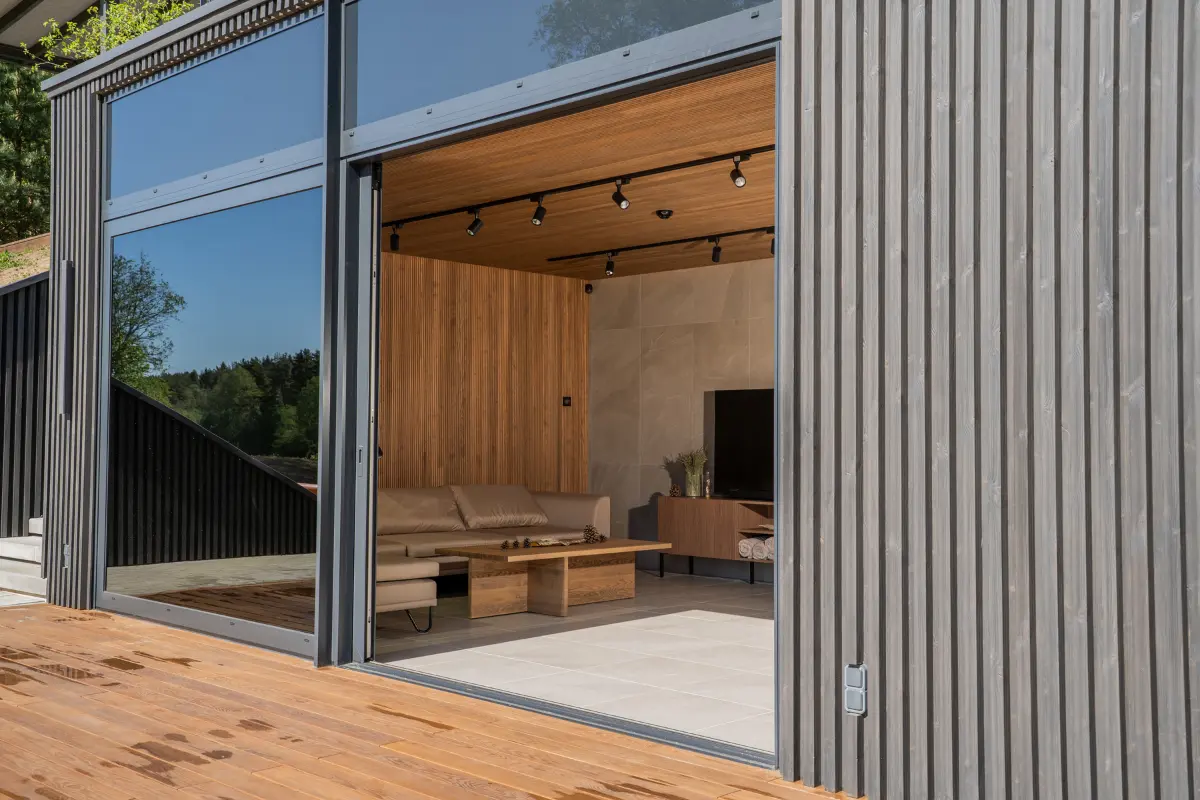Tips
Interior and Exterior Cladding: What are the Key Differences?
Cladding is one of the most versatile finishing materials used both inside and outside of buildings. It not only adds aesthetic finish to a space, but also performs practical functions: it helps to hide wall irregularities, improves acoustics, and protects building structures from environmental influences. However, interior cladding and exterior cladding differ in their properties, purpose, and durability requirements. Understanding these differences is essential for anyone planning a home or commercial space renovation, as properly selected cladding will ensure both beauty and functionality for many years to come.
Interior Cladding: Cosiness and Functionality
Cladding boards remain one of the most popular solutions for interior decoration, creating a warm and natural interior. ESSPO Wood uses spruce and pine wood – this wood is characterised by light, cosy colours and a subtle grain, giving rooms a feeling of lightness and cleanliness.
In addition to their aesthetic appeal, interior wood cladding also has practical functions. It helps to conceal uneven walls and enhances the room’s acoustics, making the sound within more pleasant. Additionally, wooden cladding offers a natural warmth, enhancing the cosiness of both living and leisure spaces.
Another important advantage is their versatility. Interior cladding complements both modern minimalist interiors and classic or rustic style solutions. A wide selection of profiles, colours, and surface finishes allows them to be adapted to various projects.
As these finishing materials are affordable, they can be chosen for both small home renovations and larger interior design projects. This makes interior cladding a practical, aesthetic, and reliable choice.
Exterior Cladding: Safety and Durability
Exterior wood cladding is primarily intended for finishing building facades, so its purpose is not only aesthetic but also protective. This material helps to ensure the durability of structures and protects them from moisture, wind, and temperature fluctuations. For these reasons, ESSPO Wood’s thermally modified wood cladding – most commonly made of thermo pine or thermo spruce – is chosen for exterior finishing. For premium projects requiring a darker tone and maximum density, thermo ash is also available as a high-end option.
Thermo wood is highly valued for its properties. Produced without chemical additives, thermo wood is an environmentally friendly choice that combines natural durability with aesthetic appeal. Special thermal treatment makes it resistant to environmental influences, reduces moisture absorption, and increases dimensional stability. This means that such exterior cladding retains its shape longer, does not deform or crack as quickly, and therefore lasts significantly longer than untreated wood.
Another advantage is the installation options. Depending on the design concept, you can choose between horizontal or vertical cladding. Horizontal installation gives a subtle and uniform look, while vertical installation helps to elongate the building and visually emphasise its height.
From an aesthetic point of view, exterior siding allows the facade to take on both a modern minimalist and a traditional natural look, making it ideal for architectural projects of various styles.
Key Differences Between Interior and Exterior Cladding
Although interior and exterior wood cladding may appear similar at first glance, their purpose and characteristics differ significantly. Lighter types of wood, such as pine or spruce, are usually used for interior finishing because they provide a natural, cosy feel and are easily adaptable to various interior styles. Meanwhile, thermo ash is most often chosen for exterior finishing, as it is durable and resistant to environmental factors.
Interior wood cladding is primarily focused on aesthetics and comfort, whereas external timber cladding is primarily focused on resistance to moisture, temperature fluctuations, and mechanical impacts. The installation also differs: for interior finishing, integrity and visual appearance are essential, while for exterior finishing, proper ventilation and durability must be ensured.
For example, pine cladding is perfect for creating a cosy atmosphere in a bedroom or living room. In contrast, thermo-treated outdoor cladding is ideal for facades or terrace walls, as it will remain stable and beautiful for many years.
How to Choose the Right Cladding?
When selecting cladding, it is essential to consider the project type, budget, and desired aesthetic. Lighter, natural wood colours such as spruce or pine are recommended for interior decoration, as they give rooms a cosy and warm feel. For exterior cladding, it is worth choosing thermo ash, which is characterised by its durability and resistance to environmental influences. In addition to the type of wood, it is essential to consider the profile, thickness, and installation method of the cladding to ensure a finish that is both aesthetically pleasing and functional.
The Right Choice – For Beauty and Durability
Therefore, properly selected cladding boards ensure both aesthetic appeal and functionality. Internal timber cladding creates a warm and cosy atmosphere, hides wall imperfections, and improves acoustics. Meanwhile, external timber cladding protects facades from moisture and temperature fluctuations, preserving the building’s beauty for many years. Regular maintenance with UV-protective oil every few years helps to preserve the natural shade and extend the lifespan of the facade. Contact the ESSPO Wood team – we will help you choose the best option!
